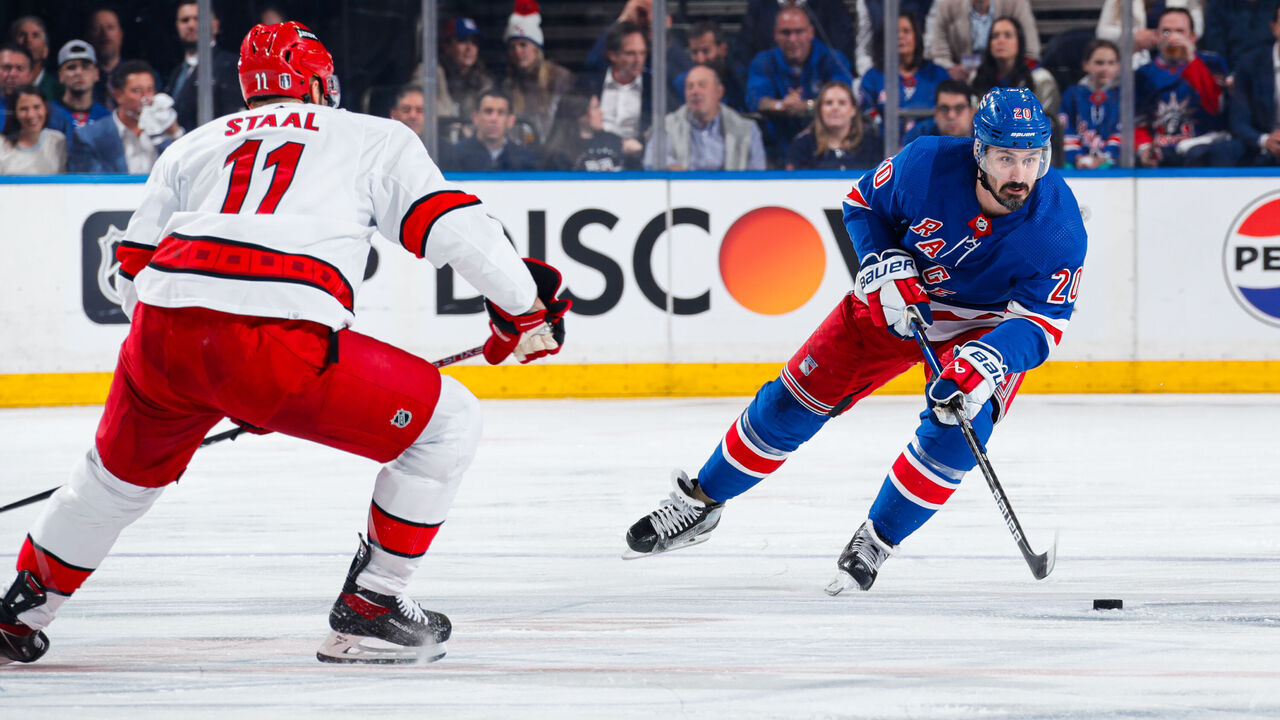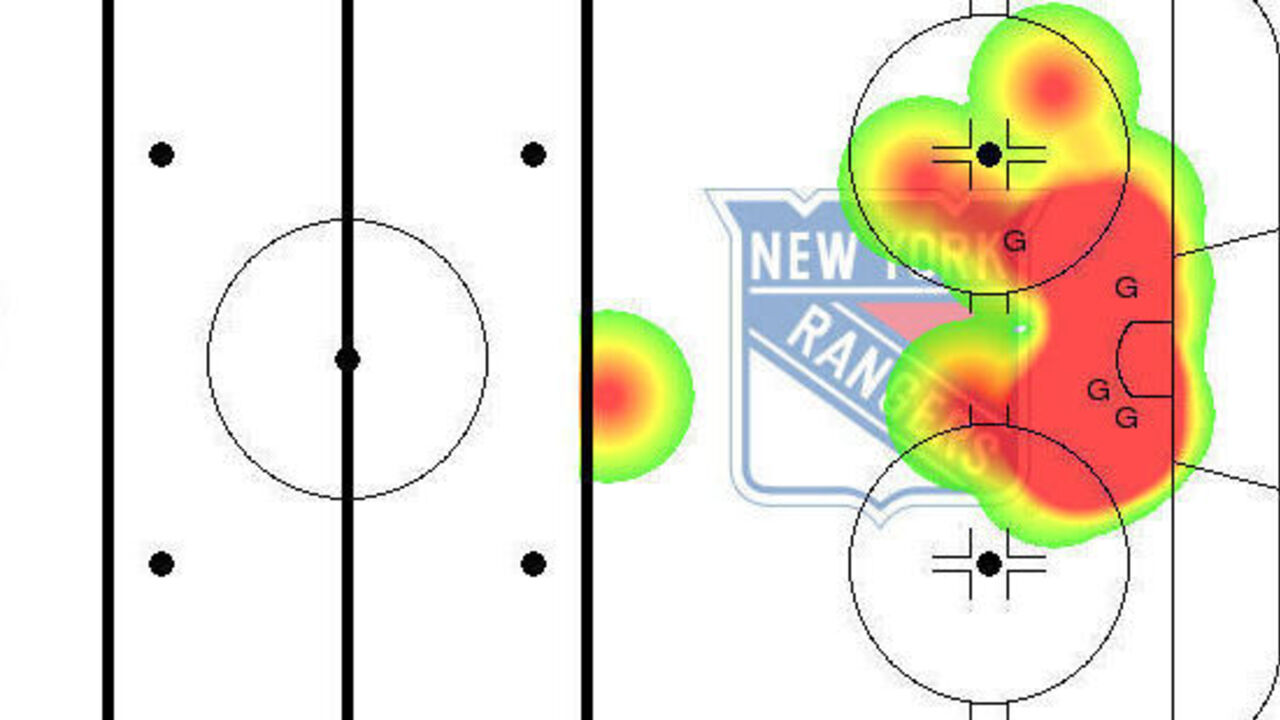Rangers have found perfect recipe for modern power play
Late Tuesday night, defenseman Jalen Chatfield intercepted a pass behind the Carolina Hurricanes' net and whipped the puck down the ice to kill time on a New York Rangers power play during the second overtime frame in Game 2.
Phew, crisis averted - or so Chatfield thought.
Rangers goalie Igor Shesterkin stepped out of his crease and made a one-touch pass to Mika Zibanejad at center ice. Zibanejad made a clean entry into the Hurricanes' zone before losing the puck along the wall. Chris Kreider was nearby to regain possession and feed Artemi Panarin in the high slot. A Carolina player blocked Panarin's shot, but Zibanejad was nearby to whack at the rebound. Shot stopped again. This time, Vincent Trocheck was nearby.
Trocheck, a former Cane, promptly shoveled the puck through Frederik Andersen's five-hole for the Rangers' fourth power-play goal and second win of the series.
VINCENT TROCHECK!!! 😱
— NHL (@NHL) May 8, 2024
He nets the winner in @SportChek double OT against his former squad! #StanleyCup pic.twitter.com/JZr4f2Y0JP
Those 14 seconds - from Shesterkin's breakout pass to Trocheck's goal - express so much about what makes New York a terrifying five-on-four team. With the Rangers getting outscored 6-4 at even strength, they wouldn't be up 2-0 heading into Thursday's Game 3 in Raleigh if not for special teams.
Let's dig into the key components of the Rangers' power play, which ranked third in the regular season and has produced 10 goals in six playoff games.
Controlled entries
There's nothing pretentious about New York's transition game at five-on-four.
Unlike many other power plays in the league, the Rangers don't rely on one very specific strategy for exiting the defensive zone, traveling through neutral ice, and entering the opposition's end. The top unit doesn't have a designated puck transporter, either. The players adjust on the fly to the defensive scheme.
The Rangers use drop passes like every other team. However, if the drop pass doesn't make sense under certain circumstances, they don't force the issue.

Perhaps most crucially, there's a strong sense of urgency to the transition game. For instance, if New York allows a shorthanded scoring chance (which it has done regularly against Carolina), the top unit doesn't tense up or try to tame the chaos. Instead, it immediately counters with a chance the other way.
All of this has resulted in a 76% zone entry success rate against the Capitals and Hurricanes (New York swept Washington in Round 1). That rate leads all playoff teams - yes, even Connor McDavid's Oilers - according to Sportlogiq.
The Rangers have potted four goals in just nine minutes of power-play time in the second round. The puck has crossed the line 9, 14, 45, and 47 seconds into the opportunities due in large part to that all-business transition game.
In-zone movement
Ever since Trocheck joined the club in the fall of 2022, the Rangers have found tremendous success with Adam Fox running the point, Trocheck occupying the bumper role, Kreider at the net, and Panarin and Zibanejad on the flanks.
Each player is fully capable of being a crafty distributor or shooting threat, and the unit knows snapping the puck around - especially east to west and west to east - is how you outduel goalies in today's NHL. New York leads all playoff teams with 21.4 offensive-zone passes per two minutes of power-play time.

Also of note: The top unit isn't obsessed with the perfect look. It's more interested in acting upon the first high-quality look of the possession, with the puck seeming to always find its way to the inner slot. (The red blob in the heat map above represents the Rangers' power-play shot locations in Round 2.)
The inner slot is a small piece of offensive-zone real estate ruled by Kreider, whose 18 power-play goals paced all Rangers in the regular season, and Trocheck, who's leading the playoff charge with four. Both have made a career out of redirecting, tipping, and poking pucks past goalies. And the other three top-unit guys, particularly Zibanejad, aren't afraid to crash the net, either.
The Rangers' average shot distance on the power play: 21.6 feet. The Hurricanes': 31.7. Guess which team has failed to capitalize in 15 power-play minutes because it's spending far too much time on the O-zone's perimeter.
Loose-puck recoveries
Trocheck's been a menace in the faceoff circle to start the playoffs, winning 76 of 127 draws (60%), including 21 of 30 (70%) on the man advantage.
This has allowed the top unit to assert itself on the opening possession. Not every shot attempt hits the net, though, so winning puck races is essential. Truthfully, hemming in the penalty killers is half the battle in the modern NHL.
The Rangers have been exceptional at chasing down pucks against the Canes. While the first power-play goal of the series was a thing of beauty (Trocheck won the faceoff, then all five Rangers touched the puck ahead of Zibanejad's goal), the other three were more hustle than finesse. The second and fourth goals featured Trocheck jumping on a short rebound, and right before the third goal (shown below), Panarin pounced on a Carolina turnover.
CHRISTOPHER FREAKING KREIDER pic.twitter.com/TSTpYWk8Sp
— Sportsnet (@Sportsnet) May 8, 2024
The final key component is Shesterkin's brilliance.
He's done his job on New York's penalty kill (two goals against in six games) and also turned aside multiple odd-man rushes on Carolina's penalty kill.
If the top unit doesn't fully trust Shesterkin and his abilities, the other pillars of success - controlled entries, in-zone movement, loose-puck recoveries - start crumbling. Plus, hey, Shesterkin led the breakout on the Game 2 winner.
John Matisz is theScore's senior NHL writer. Follow John on Twitter (@MatiszJohn) or contact him via email ([email protected]).
HEADLINES
- Trade grades: Wild instantly become Cup contenders, Canucks score quantity
- Bedard injured in final second vs. Blues on 'freak accident'
- Canucks GM: Hughes trade not because of a culture problem
- Canucks trade Hughes to Wild in blockbuster
- Trade grades: Oilers gamble on Jarry, Penguins make out like bandits